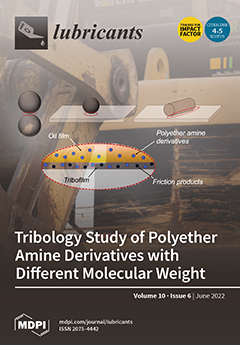Aqueous nanolubricants containing ZrO
2 nanoparticles, graphene oxide (GO) nanosheets, or hybrid nanoparticles of ZrO
2 and GO were formulated using a cost-effective ultrasonication de-agglomeration method. The friction and wear characteristics of these water-based nanolubricants were systematically investigated using a block-on-ring testing configuration
[...] Read more.
Aqueous nanolubricants containing ZrO
2 nanoparticles, graphene oxide (GO) nanosheets, or hybrid nanoparticles of ZrO
2 and GO were formulated using a cost-effective ultrasonication de-agglomeration method. The friction and wear characteristics of these water-based nanolubricants were systematically investigated using a block-on-ring testing configuration with a stainless- and alloy steel contact pair. The concentrations and mass ratios of nanoadditives were varied from 0.02 to 0.10 wt.% and 1:5 to 5:1, respectively, to obtain optimal lubrication performance. The application of a 0.06 wt.% 1:1 ZrO
2/GO hybrid nanolubricant resulted in a 57% reduction in COF and a 77% decrease in wear volume compared to water. The optimised ZrO
2/GO hybrid nanolubricant was found to perform better than pure ZrO
2 and GO nanolubricant in terms of tribological performance due to its synergistic lubrication effect, which showed up to 54% and 41% reductions in friction as well as 42% and 20% decreases in wear compared with 0.06 wt.% ZrO
2 and 0.06 wt.% GO nanolubricants. The analysis of wear scars revealed that using such a ZrO
2/GO hybrid nanolubricant yielded a smooth worn surface, with 87%, 45%, and 33% reductions in
Sa compared to water and 0.06 wt.% ZrO
2 and 0.06 wt.% GO nanolubricants. The superior tribological performance can be ascribed to the combination of the rolling effect of ZrO
2 nanoparticles and the slipping effect of GO nanosheets.
Full article





